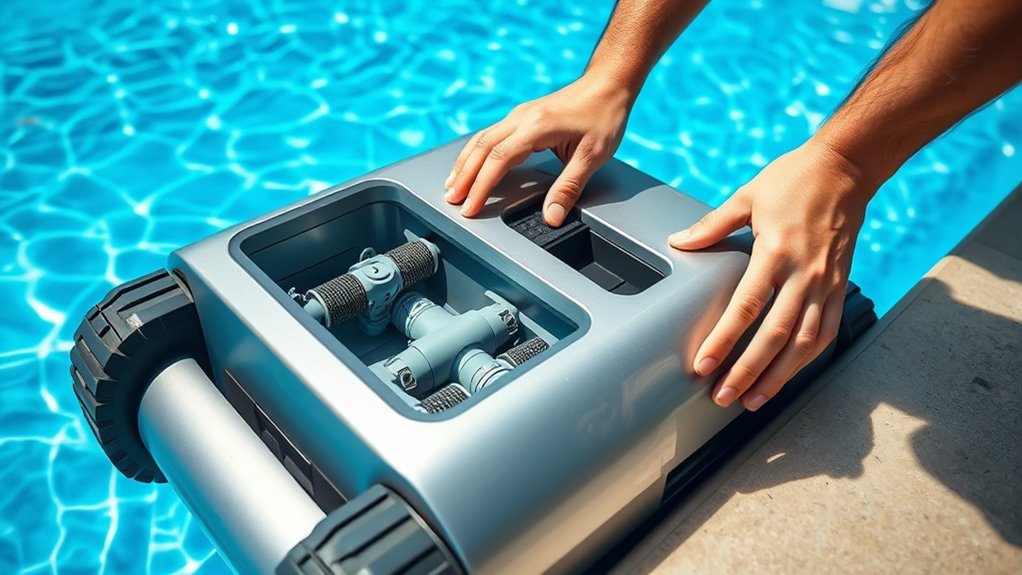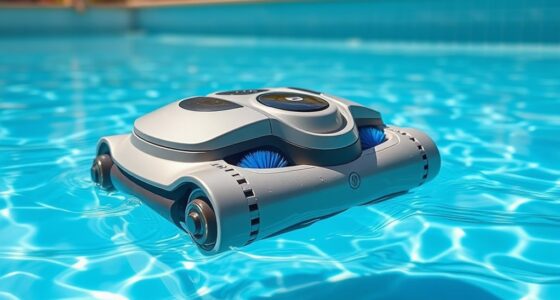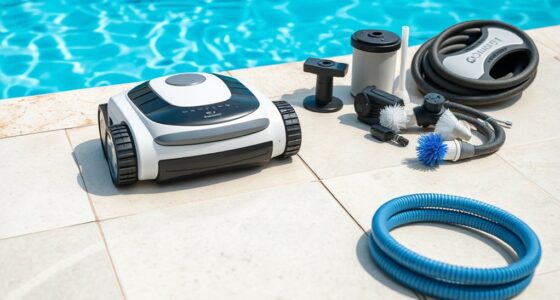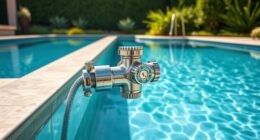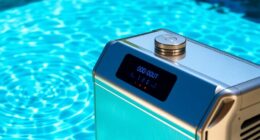To keep your robotic pool cleaner running smoothly, regularly inspect and clean the brushes and filters to prevent debris buildup and wear. Check and replace any damaged or worn parts, like wheels or batteries, to guarantee peak performance. Clear out intake and outflow passages, especially after use, to avoid blockages. During off-season, store it in a dry, cool place, and regularly test its charging and power components. Continue exploring for detailed tips to maximize its lifespan.
Key Takeaways
- Regularly inspect and replace worn brushes and filters to maintain cleaning efficiency.
- Clear debris from intake and outflow passages before use to ensure optimal water flow.
- Check and clean power cords, battery contacts, and charging components for damage or corrosion.
- Store the cleaner in a dry, cool place, and dry all parts thoroughly during off-season.
- Update software and perform periodic performance tests to identify issues early and extend lifespan.
Cleaning and Inspecting the Brushes and Filters

Regularly cleaning and inspecting the brushes and filters of your robotic pool cleaner is essential to keep it operating efficiently. Start by checking the brushes for wear and tear; if they’re worn down, consider brush replacement to maintain cleaning performance. Remove debris from the brushes and ensure they spin freely. Next, clean the filters thoroughly—remove any dirt, algae, or debris that could clog the system. Rinsing filters under running water usually suffices, but replace them if they’re damaged or excessively dirty. Regular filter replacement is key to air quality and optimal operation, so monitor your filters regularly. Keeping the brushes and filters in good condition guarantees your cleaner works effectively, prolongs its lifespan, and prevents unnecessary strain on the motor. Incorporating proper cleaning techniques can further improve the efficiency of your robotic pool cleaner. Regular maintenance of pool equipment like this can significantly extend the life of your cleaner. Additionally, inspecting the electrical connections for corrosion or damage ensures safe and reliable operation. Implementing a consistent maintenance routine helps identify potential issues early and keeps your pool in pristine condition.
Checking and Replacing Worn or Damaged Parts

To guarantee your robotic pool cleaner performs at its best, it’s important to regularly check for worn or damaged parts. Start by inspecting the battery lifespan; if it doesn’t hold a charge, consider replacing it. Next, examine the brushes and wheels for signs of wear, replacing them to maintain efficiency. Check for cracks or damage in the power cords and housing. Also, ensure your software is up to date—software updates often improve performance and fix bugs. Additionally, self-reflection on your maintenance routines can help identify potential issues early. Regularly replacing worn parts keeps your cleaner functioning at its peak, prolongs its lifespan, and guarantees you get the most out of your investment. Routine maintenance techniques can also be applied to optimize your cleaner’s motor performance for better cleaning efficiency. Moreover, inspecting the effective components of your cleaner ensures it continues to deliver optimal results.
Clearing the Intake and Outflow Passages

Since debris can quickly clog the intake and outflow passages, it’s essential to clear them regularly to guarantee peak performance. Start by turning off your robotic cleaner and inspecting the suction pathway. Remove any debris, leaves, or dirt that may be blocking the intake or outflow vents. Use a soft brush or your fingers to gently dislodge stubborn debris, ensuring the passages remain unobstructed. Check the outflow area as well, since buildup here can reduce water flow and cleaning efficiency. Regular debris removal prevents strain on the motor and maintains best suction power. Additionally, understanding electronic component signs can help you recognize the importance of harmony and balance, which can also extend to maintaining your equipment effectively. Proper cleaning and maintenance of the suction pathway can significantly enhance the device’s lifespan. Regularly inspecting the filter system helps ensure optimal water flow and filtration efficiency. Being aware of device maintenance schedules can help you stay proactive in keeping your cleaner in top condition. Once clear, reassemble any parts and restart your cleaner. Maintaining clean intake and outflow passages helps your robotic pool cleaner operate smoothly and extends its lifespan.
Storing Your Robotic Cleaner Properly During Off-Season
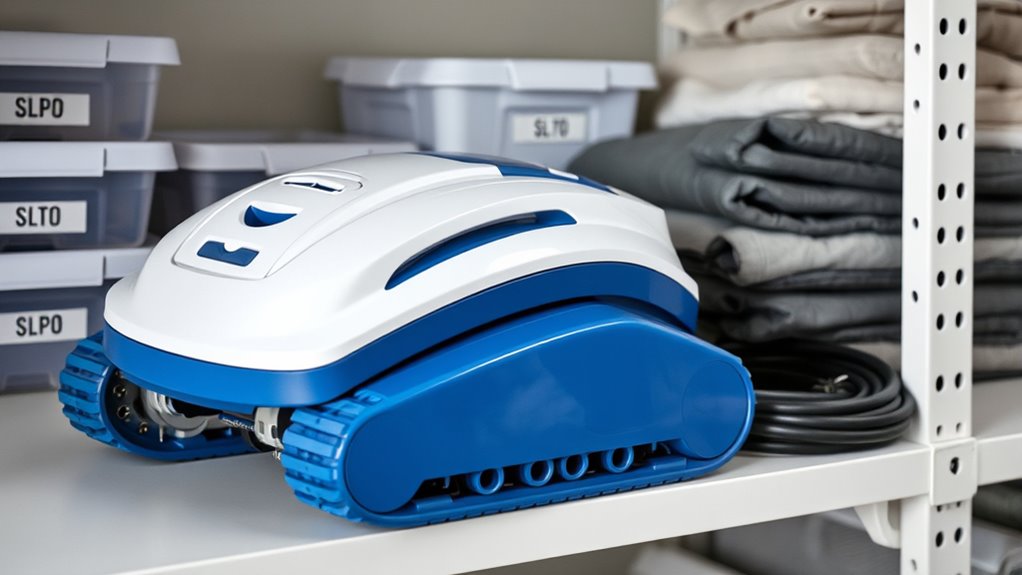
When the swimming season ends, proper storage guarantees your robotic pool cleaner remains in good condition until next year. Effective seasonal preparation involves following key storage tips to prevent damage.
- Clean the unit thoroughly, removing dirt and debris.
- Dry all components completely to prevent mold or corrosion.
- Store it in a cool, dry place away from direct sunlight.
- Keep the power cord loosely coiled to avoid damage.
- Consider emotional support practices for yourself if managing stress during maintenance, ensuring you approach the task with patience and care.
These storage tips help preserve the battery and mechanical parts, ensuring reliable performance when you start using it again. Avoid leaving the cleaner in the pool or in damp areas, as moisture can cause long-term damage. Proper seasonal preparation makes sure your robotic cleaner is ready to go when the season resumes.
Regularly Testing the Charging and Power Components

After storing your robotic pool cleaner properly for the off-season, it’s a good idea to periodically test its charging and power components. Start by inspecting the battery health—make certain it charges fully and maintains power during cleaning cycles. If the battery doesn’t hold a charge, consider replacing it to prevent operational issues. Next, check the charging contacts for corrosion or debris that could hinder power transfer. Additionally, keep your cleaner’s software updated; manufacturers often release updates that optimize performance and fix bugs related to charging or power management. Regularly testing these components helps catch problems early, prolongs the device’s lifespan, and ensures your pool cleaner operates efficiently when you need it. Staying proactive with these checks saves you time and costly repairs later. Given the increasing role of AI in device diagnostics, some modern pool cleaners now incorporate AI-driven diagnostics to assist in maintenance checks. Moreover, understanding the city dynamics in your area can help you better plan for maintenance schedules and resource availability, ensuring your equipment remains in top condition. Incorporating preventive maintenance routines can further enhance the longevity and reliability of your robotic cleaner.
Frequently Asked Questions
How Often Should I Schedule Professional Inspections for My Robotic Pool Cleaner?
You should schedule professional inspections for your robotic pool cleaner at least once a year to keep it running smoothly. Following a regular maintenance schedule helps identify issues early and guarantees peak performance. If you notice decreased cleaning efficiency or unusual noises, consider more frequent inspections. Proper professional checks can extend your cleaner’s lifespan, prevent costly repairs, and keep your pool spotless all season long.
Can I Use Household Cleaning Agents to Maintain the Robotic Cleaner’S Exterior?
You might wonder if household cleaning agents are safe for exterior maintenance of your robotic pool cleaner. It’s best to avoid harsh chemicals, as they can damage the device’s exterior and internal parts. Instead, use a damp cloth with mild soap for cleaning. Regular exterior maintenance with gentle cleaning keeps your cleaner looking good and working efficiently, extending its lifespan without risking harm from inappropriate household cleaning agents.
What Are Common Signs Indicating My Robotic Cleaner Needs Repairs?
You might think your robotic cleaner’s working fine, but watch for signs it needs repairs. Sensor malfunctions often cause it to miss spots or stop unexpectedly, while unusual motor noise indicates possible mechanical issues. If your cleaner’s behavior suddenly changes, or it stalls frequently, don’t ignore these clues. Addressing these signs early prevents bigger problems, ensuring your robot keeps your pool sparkling without costly repairs down the line.
Is It Necessary to Replace the Entire Unit if One Part Fails?
When one part fails, you might wonder if you need a full unit replacement. Usually, it’s better to contemplate repair costs first, as replacing an entire unit can be expensive. Many times, individual parts can be repaired or replaced, saving you money and extending your cleaner’s lifespan. Only opt for unit replacement if repairs become too costly or if the unit is outdated, ensuring you get the best value.
How Do I Troubleshoot Connectivity Issues Between the Cleaner and Its Remote Control?
You might worry about complicated troubleshooting, but fixing connectivity issues is straightforward. First, verify the cleaner is within range for remote pairing. Check for signal interference from other electronic devices that could disrupt the connection. Restart both the cleaner and remote control, then try pairing again. Keep your pool area clear of obstacles, and you’ll restore smooth communication quickly, saving you time and frustration.
Conclusion
By keeping up with routine maintenance, your robotic pool cleaner will stay in top shape all season long. For example, Sarah noticed her cleaner wasn’t working as efficiently, so she checked the brushes and filters—just like the guide suggested—and found a worn brush. After replacing it, her cleaner ran like new. Regular care not only extends its lifespan but also saves you time and money. Stay proactive, and your pool will stay sparkling clean effortlessly.
